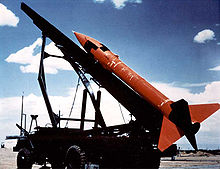Japan's non-nuclear weapons policy
Japan's non-nuclear weapons policy is a policy popularly articulated as the Three Non-Nuclear Principles of non-possession, non-production, and non-introduction of nuclear weapons imposed by Douglas MacArthur during the Allied occupation of Japan following the Second World War.
Developmental history
Following
Early public opposition
In the years after the

On 28 July 1955, the U.S. announced its intention to equip military bases in Japan with
The language of the Atomic Energy Basic Law, adopted in December 1955, reflects the public sentiment, restricting "the research, development and utilization of atomic energy" to "peaceful purposes". Nuclear power is used in Japan.
In 1957, Prime Minister
Japanese religious leaders were strongly opposed to
Satō's "Four Pillars" Policy
To ease public misgivings about his administration's nuclear ambitions, Satō introduced the Three Non-Nuclear Principles to the Diet in 1967. Retroactively, to lessen the principles' restriction on Japanese military defense options, in 1968 Satō broadened the principles into the "
This policy of nuclear abstention was justified internally by the
In 1970, as desired by the U.S. but after much hesitation and with some key stipulations, Japan signed the NPT; and in 1972, relieved of U.S. nuclear weapons, Okinawa reverted to Japanese rule. The Diet passed a resolution formally adopting the principles in 1971, though they were not made law. Eisaku Satō was presented with the Nobel Peace Prize in 1974, in large part for his work toward Japan's entry into the NPT. In his Nobel Lecture (on the seventh anniversary of his original statement to the Diet), Satō reiterated and discussed the Three Non-Nuclear Principles and expressed hope and confidence that future governments would adopt them as well.[5]
Further influence
Opinion polls have consistently revealed that public opinion is overwhelmingly opposed to nuclearization,[6] as several events over the decades following World War II, even after the end of the Cold War, have demonstrated.
The Kobe Formula
The port of Kobe was used heavily by the U.S. fleet during its postwar occupation, which ended in 1974. Throughout the occupation, U.S. military facilities at Kobe Port were the target of continuous public protest. Public petitions after Kobe's return to Japan culminated in an 18 March 1975 resolution by the city council to prohibit nuclear-armed vessels from entering the port.[7] U.S. policy being to neither confirm nor deny nuclear weapons deployment, this resolution effectively removed the U.S. naval presence from Kobe Port. Amid the presence of nuclear-powered U.S. vessels and concerns that the government allowed nuclear-armed warships into Japanese ports (later confirmed), this resolution became the first major application of the three non-nuclear principles. The strict policy has become known as the "Kobe Formula", and since its inception several thousand Japanese municipalities have adopted similar nuclear-free resolutions.[8]
Review
In recent years Japanese policymakers have been increasingly public in calling the three non-nuclear principles into question. In October 1999,
In May 2002 Deputy Chief Cabinet Secretary
Fukuda was not forced to resign; Prime Minister Junichiro Koizumi described his remarks as "simply an observation that any basic policy of a country can be reviewed" and insists that his government has no intention of reviewing the principles.[11] Koizumi continues to reaffirm the principles in each of his addresses for the Hiroshima and Nagasaki Peace Memorial Ceremonies.[12]
More fervent criticism of Japan's non-nuclear policy has come from a few well-known academics and writers, including Kyoto University professor Terumasa Nakanishi and literary critic Kazuya Fukuda (who penned the article "A nuclear declaration for Japan" for Voice magazine). The majority of writers and scholars, however, tend to support non-nuclearism.
Japan decided not to sign the UN treaty on the
See also
- Japanese Peace Bell
- Three Non-Nuclear Principles
- Article 9 of the Constitution of Japan
- M-5 rocket
- Japanese nuclear weapon program
- Nuclear latency
- Nuclear umbrella
- New Zealand nuclear-free zone
References
- ISBN 0-8447-3114-5
- ISBN 0-231-03447-4
- ISBN 0-8157-1331-2
- ^ "Peace Prize winner Sato called nonnuclear policy 'nonsense'". The Japan Times, 11 June 2000.
- ^ Eisaku Satō's Nobel Lecture, 11 December 1974.
- ^ Kamiya, Matake (2002). "Nuclear Japan: Oxymoron or Coming Soon?". The Washington Quarterly 26 1: 63–75.
- ^ "Resolution on the Rejection of the Visit of Nuclear-Armed Warships into Kobe Port". Kobe City Council, 18 March 1975.
- ^ Kajimoto, Shushi (2001). "Role of Non-Nuclear Kobe Formula in Establishing Nuclear Weapons Free Zones" Archived 26 November 2004 at the Wayback Machine. 2001 World Conference against A & H Bombs, 3–5 August 2001.
- ^ French, Howard W. (1999). "Furor in Japan as Military Official Advocates Nuclear Weapons". The New York Times, 21 October 1999.
- ^ "Non-nuclear principles to be reviewed". Chūgoku Shimbun Peace News, 2 June 2002.
- ^ Berkofsky, Axel (2002). "Koizumi under a nuclear smokescreen". Asia Times, 13 June 2002.
- ^ Address by Prime Minister Junichiro Koizumi at the Hiroshima Memorial Service, 6 August 2005.
- ^ "AP Explains: Why Japan doesn't sign nuclear arms ban treaty". Associated Press. 22 September 2017.
External links
- Akaha, Tsuneo (1984). "Japan's Nonnuclear Policy". The Regents of the University of California, 1984.
- Sherrill, Clifton W. (2001). "The Need for a Japanese Nuclear Deterrent". Comparative Strategy 20 3: 259–270.
- Andrew L. Oros (2003). "Godzilla's Return: The New Nuclear Politics in an Insecure Japan". In Japan's Nuclear Option: Security, Politics, and Policy in the 21st Century, ISBN 0-9747255-6-0
- Japan's Nuclear Weapons Program at GlobalSecurity.org.

